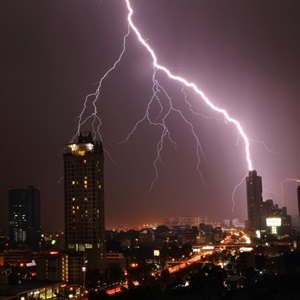
A violent thunderstorm can create havoc wherever it strikes. Buildings can be damaged, trees can be blown over, and if lightning strikes a person, the electric shock can be fatal. But can it trigger an asthma attack, resulting in death?
Absolutely, says research from the Australian Society of Clinical Immunology and Allergy. Pollen allergens can trigger asthma, and these allergens are often picked up by thunderstorms.
Read: Make your bedroom allergy safe
Recently eight people died from so-called “thunderstorm asthma” in Melbourne in Australia. According to a report in the New York Times, thousands of people in suffered an asthma attack and flooded “the city’s emergency rooms, swamped ambulance call lines and joined lines around pharmacies”.
What is ‘thunderstorm asthma’?
According to research published in the monthly journal of the Association of Physicians, “thunderstorm asthma is a term used to describe an observed increase in acute bronchospasm cases following the occurrence of thunderstorms in the local vicinity”.
“The roles of accompanying meteorological features and aeroallergens, such as pollen grains and fungal spores, have been studied in an effort to explain why thunderstorm asthma does not accompany all thunderstorms.”
In essence, this phenomenon is a potentially dangerous mix of pollens, weather conditions involving a thunderstorm, and rain that leads to severe asthma symptoms. The thunderstorm is directly linked to asthma attacks.
Read: Is it safe to use an asthma inhaler if I don't have asthma?
Why it occurs
Some grass allergens are located in pollen grains. When it rains or is humid (which is the case during a thunderstorm) these grains can absorb moisture and burst. This releases small allergenic particles that can find their way deep into the lungs.
Some people who develop “thunderstorm asthma” have had severe pollen allergic rhinitis before, and when the lungs absorb these allergens, it may cause an attack.
How to avoid it
An asthma attack suffered during a thunderstorm is no different from a normal asthma attack, but the degree of severity and the number of people who are susceptible are likely to be different.
The research organisation Asthma UK recommends the follow guidelines to avoid an attack:
- Take your medication as prescribed. This includes carrying your inhaler with you at all times.
- Make sure you are using your inhaler correctly.
- Go for regular asthma reviews if asthma runs in your family.
- Keep an eye on the weather forecast.
- Stay inside with windows closed (reducing the chances of pollen making its way into the room).
Even if you don’t have asthma . . .
If you normally suffer from hay fever, you can develop asthma during a heavy thunderstorm. Know the symptoms: coughing, chest tightness, wheezing or not being able to breathe properly. Identifying these symptoms during thunderstorm might save your life. Get immediate medical attention.
Read more:
10 famous people living with asthma
Asthma one of top 5 causes of death in US
This app can diagnose your illness by listening to your cough




 Publications
Publications
 Partners
Partners















